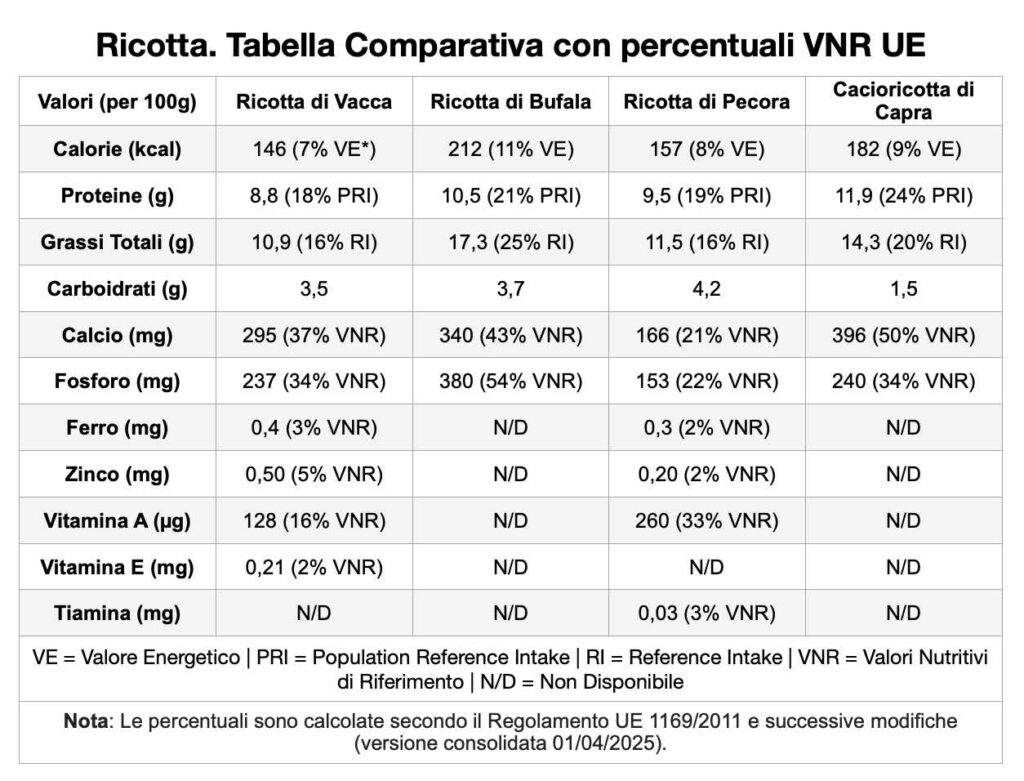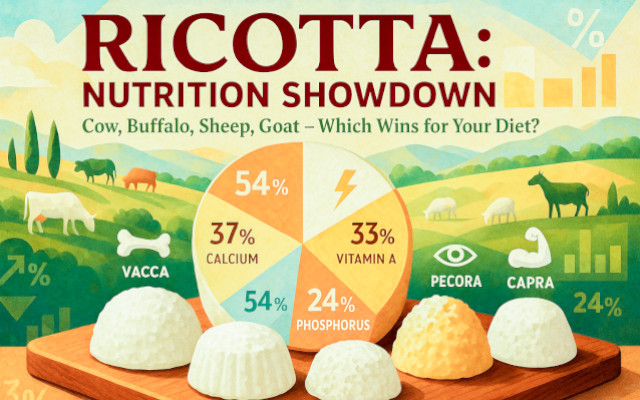ricotta cheese di cow, buffalo, sheep e goat They are among the most widespread varieties of ricotta in the Italian dairy tradition, each with organoleptic characteristics distinctive but also with unique nutritional profiles that vary in relation to the milk used and the grazing of the animals.
This fresh dairy product, obtained from the whey that remains from cheese making, is distinguished by its delicate flavor , versatility in the kitchen.
Analyzing the nutritional profiles of each of these types is useful to promote informed choices of consumption, to ensure that everyone can choose the ricotta that best suits their needs. Even in the event of food intolerances.
Exclusive
The data presented in this analysis come from the Food Composition Tables (update 2019) of CREA (Council for Agricultural Research and Analysis of Agricultural Economics), as well as by some scientific studies.
Il CREA represents the reference body in Italy for:
the collection of experimental nutritional data;
the analysis of the composition of foods consumed in Italy;
the dissemination of reliable nutritional information.
Cow Ricotta: Nutritional Profile
Average nutritional values per 100g
Macronutrients:
Energy value: 146 kcal (7% of daily energy requirement*)
Protein: 8,8 g (18% PRI**)
Total fat: 10,9 g (16% RI***)
Carbohydrates: 3,5 g (of which lactose: 3,5 g)
Fiber: 0 g.
Minerals and % of EU Nutrient Reference Values:
Calcium: 295 mg (37% RDA)
Phosphorus: 237 mg (34% RDA)
Potassium: 119 mg (6% RDA)
Sodium: 78 mg (3% NRV)
Iron: 0,4 mg (3% NRV)
Magnesium: 17 mg (5% RDA)
Zinc: 0,50 mg (5% NRV)
Selenium: 3,9 µg (7% NRV).
Vitamins and % of EU Reference Nutrient Values:
Vitamin A: 128 µg (16% NRV)
Vitamin E: 0,21 mg (2% RDA)
Vitamin C: 0 mg (0% NRV).
Lipid profile:
Saturated fatty acids: 68,01%
Monounsaturated fatty acids: 27,52%
Polyunsaturated fatty acids: 3,89%
Polyunsaturated/saturated ratio: 0,06.
Major amino acids (% of protein):
Lysine: 9,02%
Leucine: 11,33%
Valine: 6,04%
Isoleucine: 5,30%
Methionine: 2,31%.
Average energy intake of 2000 kcal per day | *Population Reference Intake | **Reference Intake | NRV = Nutrient Reference Values
Buffalo Ricotta: A Concentration of Nutrients
Average nutritional values per 100g
Macronutrients:
Energy value: 212 kcal (11% of daily energy requirement) – the most caloric among all ricottas
Protein: 10,5 g (21% RDA)
Total fat: 17,3 g (25% RI) – highest fat content
Carbohydrates: 3,7 g.
Minerals and % of EU Nutrient Reference Values:
Calcium: 340 mg (43% NRV) – 15% higher than cow’s milk ricotta
Phosphorus: 380 mg (54% NRV) – the highest among all ricottas, exceeding cow ricotta by 60%
Other minerals: Data not available (CREA, 2019).*
Vitamins:
Vitamin C: 0 mg (0% NRV)
Other vitamins: Data not available (CREA, 2019).*
Distinguishing features
Higher energy and lipid content than other ricottas (Addeo et al., 2004)
Excellent source of calcium and phosphorus, particularly indicated for supporting bone health (Salvador et al., 2006)
Particularly rich nutritional profile due to the unique characteristics of buffalo milk (Salvador et al., 2006)
Buffalo ricotta has limited data in the CREA database (CREA, 2019). Manufacturers should provide nutritional information based on analytical data.
Sheep Ricotta: Nutritional Balance
Average nutritional values per 100g
Macronutrients:
Energy value: 157 kcal (8% of daily energy requirement)
Protein: 9,5 g (19% RDA)
Total fat: 11,5 g (16% RI)
Carbohydrates: 4,2 g.
Minerals and % of EU Nutrient Reference Values:
Calcium: 166 mg (21% RDA)
Phosphorus: 153 mg (22% RDA)
Sodium: 85 mg (4% NRV)
Potassium: 98 mg (5% RDA)
Iron: 0,3 mg (2% NRV)
Magnesium: 15 mg (4% RDA)
Zinc: 0,20 mg (2% NRV)
Copper: 0,05 mg (5% NRV).
Vitamins and % of EU Reference Nutrient Values:
Vitamin A: 260 µg (33% NRV) – the highest among all ricottas
Thiamine (B1): 0,03 mg (3% NRV) – only source among the ricottas analyzed
Vitamin C: 0 mg (0% NRV).
Lipid profile:
Saturated fatty acids: 69,57%
Monounsaturated fatty acids: 23,63%
Polyunsaturated fatty acids: 6,43% (the highest among the ricottas analyzed)
Polyunsaturated/saturated ratio: 0,09 – higher than cow’s ricotta (0,06) (CREA, 2019).
Major amino acids (% of protein):
Lysine: 8,57%
Leucine: 10,75%
Valine: 6,05%
Isoleucine: 5,09%
Methionine: 2,13% (CREA, 2019).
Goat Ricotta: The Protein Champion
Average nutritional values per 100g
Macronutrients:
Energy value: 182 kcal (9% of daily energy requirement)
Protein: 11,9 g (24% PRI) – the highest among all ricottas analyzed, 13% higher than cow’s milk ricotta
Total fat: 14,3 g (20% RI)
Carbohydrates: 1,5 g – the lowest of all ricottas, 57% lower than cow ricotta.
Minerals and % of EU Nutrient Reference Values:
Calcium: 396 mg (50% NRV) – the highest content among all ricottas, 34% higher than cow’s milk ricotta and 16% higher than buffalo milk ricotta
Phosphorus: 240 mg (34% RDA)
Other minerals: Data not available (CREA, 2019).*
Vitamins:
Vitamin C: traces (<1% VNR) – only ricotta with detectable presence of vitamin C
Other vitamins: Data not available (CREA, 2019).*
Distinguishing features
Best protein profile among ricottas for amino acid completeness and digestibility (Salvador et al., 2006)
Content of Calcium exceptional (50% VNR), particularly bioavailable in goat milk (Salvador et al., 2006)
Low carb, great for diets low carb and glycemic control (CREA, 2019)
Traditionally produced with goat’s milk from Mediterranean pastures, a source of medium chain fatty acids benefits (Licitra et al., 2010)
Goat ricotta has limited data in CREA databases (CREA, 2019). Specialized studies indicate unique nutritional properties of goat milk (Salvador et al., 2006).

Which Ricotta to Choose: Guide to Nutritional Requirements
For those who want to reduce calories
Cow ricotta – Lower energy intake (146 kcal/100g), lower fat content (10,9g) and more favorable protein-calorie ratio (CREA, 2019)
For those looking for more protein
Goat ricotta – The highest protein content (11,9 g/100g, 24% PRI) with high biological quality proteins and complete amino acid profile (CREA, 2019; Salvador et al., 2006).
For those who need calcium
Goat ricotta – 396 mg of calcium per 100g (50% VNR), the highest of all, with superior bioavailability thanks to the characteristics of goat’s milk (CREA, 2019; Salvador et al., 2006).
For those who are lactose intolerant
Sheep or goat ricotta – Potentially better options than cow ricotta which (apart from that produced with lactose-free milk) contains 3,5g of lactose per 100g. The production process reduces lactose by 60-70% compared to the starting milk (Licitra & Locci, 2014).
For those who want better quality fats
Sheep ricotta – Higher percentage of polyunsaturated fats (6,43%) and better polyunsaturated/saturated ratio (0,09), particularly beneficial from grazing with +40% omega-3 (CREA, 2019; Caprioli et al., 2019).
Impact of pasture quality and production on nutritional values
Nutritional variability related to breeding
La nutritional quality of ricotta varies significantly based on:
1. Type of livestock feed
Grazing animals produce milk richer in:
omega-3 and beneficial fatty acids (200-300% increase);
vitamins A and D (30-50% increase);
natural antioxidants, particularly carotenoids and polyphenols (Carpino et al., 2004; Licitra et al., 2010).
2. Seasonality and grazing
Spring and summer ricotta from pasture features:
better lipid profile with greater presence of CLA (conjugated linoleic acid);
higher content of fat-soluble vitamins (+25-35% compared to winter);
yellowish color, due to the beta-carotene in fresh forage (Piredda et al., 2021).
3. Breeds and genetics
According to some authors (Maniaci et al., 2013), native grazing breeds (e.g. Siciliana, Comisana for sheep) produce ricotta with:
superior amino acid profile, particularly rich in essential amino acids;
higher concentration of minerals (+10-20% calcium and phosphorus);
improved protein digestibility (biological value increased by 15%).
Example: Sicilian ricotta from pasture
Ricotta produced with milk from sheep grazing in Sicily shows significant nutritional benefits (Mangione et al., 2025). The differences were estimated as:
+40% polyunsaturated fatty acids compared to ricotta from animals fed with feed (Caprioli et al., 2019)
30% more vitamin A, thanks to the beta-carotene present in pasture grasses (Caprioli et al., 2019)
more complex aromatic profile with a higher presence of natural terpenes (Caprioli et al., 2019)
best omega-6/omega-3 ratio (1:4 vs 1:8 of industrial ricotta) (Caprioli et al., 2019).
Research shows that the Mediterranean extensive grazing gives Sicilian ricotta superior nutritional characteristics (Licitra et al., 2010; Carpino et al., 2004).
Ricotta, nutritional and health benefits
Bone health
Ricotta cheese is an excellent source of nutrients for bones (Maniaci et al., 2013):
Calcium up to 50% VNR in 100g (goat ricotta) with high bioavailability (Salvador et al., 2006);
Phosphorus up to 54% VNR in 100g (buffalo ricotta) for an optimal calcium/phosphorus ratio (CREA, 2019);
protein, essential for the bone matrix, with a higher chemical index (135-140) which indicates high protein quality (CREA, 2019).
High biological value proteins
Ricotta provides superior proteins in terms of quality and digestibility (Licitra & Locci, 2014):
all essential amino acids in optimal proportions;
high biological value with chemical index 135-140 (CREA, 2019);
easy digestibility, especially for goat and sheep ricotta (Salvador et al., 2006).
Essential Micronutrients
Vitamin A up to 33% VNR (sheep ricotta), increased by 30% in pasture products (CREA, 2019; Caprioli et al., 2019)
Football: 21-50% VNR per 100g, with greater bioavailability in goat ricotta (CREA, 2019; Salvador et al., 2006)
Phosphorus and Potassium: 22-54% VNR per 100g (CREA, 2019)
Protein: 18-24% PRI per 100g with complete amino acid profile (CREA, 2019).
Tips for consumption and storage
How to store ricotta
in the refrigerator at +4°C to preserve nutritional quality (Licitra & Locci, 2014);
close the container well to avoid oxidation of vitamins and fats (Salvador et al., 2006);
consume within 3-5 days of opening to maintain optimal nutritional properties (CREA, 2019).
Ideas for optimal consumption
as an ingredient, in sweet and savoury dishes, to increase the protein intake without exceeding the energy value;
in salads, to take advantage of bioavailable calcium and complete proteins (Salvador et al., 2006);
as a snack, with dried fruit, to combine proteins and beneficial fatty acids from grazing (Caprioli et al., 2019);
in baked preparations such as cheesecake, preserving nutritional qualities at moderate temperatures (Licitra & Locci, 2014).
Conclusions: to each his own ricotta
The choice of the ideal ricotta depends on the sensory needs of each individual. From the point of view of nutritional profiles, the different ricottas are characterized in summary as follows:
cow ricotta. Perfect for those looking for a light product with a good basic nutritional profile (37% VNR calcium, 16% VNR vitamin A);
buffalo ricotta. Ideal for those who want to maximize their mineral intake – particularly calcium (43% NRV) and phosphorus (54% NRV), the highest among all ricottas;
ricotta. Excellent for vitamin A (33% NRV, the highest) and quality fats with the best polyunsaturated/saturated ratio (0,09);
goat ricotta. Excellent for protein (24% PRI, the highest) and calcium (50% VNR, the highest among all) (CREA, 2019).
Tips for maximizing nutritional quality
Give priority to pasture products when available – can provide up to 40% more polyunsaturated fatty acids (Caprioli et al., 2019)
Check the seasonality – spring/summer ricotta has superior nutritional profiles with +25-35% fat-soluble vitamins (Piredda et al., 2021)
Choose local producers which specify the type of feeding of the animals and use native breeds for better nutritional quality (Licitra et al., 2010)
Read the label – look for complete information on nutritional values and prefer products with declarations on the origin of the milk.
Ricotta represents a functional food which, especially if grazed, can contribute significantly to the need for high quality organic proteins (chemical index 135-140), calcium (up to 50% VNR), phosphorus and fat-soluble vitamins, with scientific evidence demonstrating the nutritional superiority of Mediterranean pasture products (Carpino et al., 2004; Licitra et al., 2010).
Ricotta and diet, questions and answers
Does ricotta make you fat?
No. Cow ricotta provides only 7% of the daily energy requirement per 100g. It is rich in proteins (18% PRI) which increase satiety.
Which ricotta has the most protein?
Goat ricotta contains 11,9g of protein per 100g (24% PRI), followed by buffalo ricotta (21% PRI).
How to choose ricotta to maximize nutrients?
For calcium: goat ricotta (50% VNR)
For vitamin A: sheep ricotta (33% VNR)
For protein: goat ricotta (24% PRI)
For quality fats: sheep ricotta (6,43% polyunsaturated)
Does pasture quality influence nutritional values?
Yes, to a significant extent. Pasture ricotta can contain up to:
40% more polyunsaturated fatty acids
30% more vitamin A
higher intake of omega-3 fatty acids.
Can I eat ricotta if I am lactose intolerant?
Cow’s milk ricotta contains 3,5g of lactose per 100g, in addition to the lactose-free versions. Other varieties may contain less, also taking into account that ricotta generally has less lactose than the starting milk, but in case of diagnosed lactose intolerance you should always check the label and choose lactose-free products.
Does ricotta have a good protein profile?
Yes, excellent. Ricottas provide complete proteins with high biological value (chemical index 135-140) and all essential amino acids (CREA, 2019). Goat ricotta offers the superior protein profile with 11,9g per 100g (24% PRI), while cow ricotta provides 8,8g per 100g (18% PRI) but with high bioavailability (Licitra & Locci, 2014).
What is the best ricotta for athletes?
La goat ricotta It is optimal for athletes due to its superior nutritional profile: maximum protein content (11,9g, 24% PRI), high calcium (50% NRV) and low carbohydrate content (1,5g), ideal for muscle recovery and body weight management (Salvador et al., 2006).
How does grazing affect nutritional quality?
Grazing significantly improves the nutritional profile. Sicilian ricotta from pasture shows: 40% more polyunsaturated fatty acids, 30% more vitamin A, and better omega-6/omega-3 ratio (1:4 vs 1:8 industrial) (Caprioli et al., 2019). Studies confirm that grazing animals produce milk with 200-300% more omega-3 and 30-50% increases in vitamins A and D (Carpino et al., 2004; Piredda et al., 2021).
Dario Dongo
Bibliography and sources
Addeo, F., Chianese, L., & Salzano, A. (2004). Buffalo cheese. In P. F. Fox, P. L. H. McSweeney, T. M. Cogan, & T. P. Guinee (Eds.), Cheese: Chemistry, physics and microbiology (Vol. 2, pp. 405–424). Academic Press
Caprioli, G., Nzekoue, F. K., Fiorini, D., Scocco, P., Sagratini, G., & Catorci, A. (2019). The effects of feeding supplementation on the nutritional quality of milk and cheese from sheep grazing on dry pasture. International Journal of Food Sciences and Nutrition, 71 (1), 50–62. https://doi.org/10.1080/09637486.2019.1613347
Carpino, S., Mallia, S., La Terra, S., Melilli, C., Licitra, G., Acree, T. E., Barbano, DM, & Van Soest, P. J. (2004). Composition and aroma compounds of Ragusano cheese: Native pasture and total mixed rations. Journal of Dairy Science, 87 (3), 816-830. https://doi.org/10.3168/jds.S0022-0302(04)73226-9
CREATE. (2019). Food Composition Tables – Update 2019. Council for Agricultural Research and Analysis of Agricultural Economics. https://www.alimentinutrizione.it/sezioni/tabelle-nutrizionali
Licitra, G., & Locci, F. (2017). Dairy products from minor species. In Y. W. Park, G. F. W. Haenlein, & W. L. Wendorff (Eds.), Handbook of milk of non-bovine mammals (2nd ed., pp. 390–425). Wiley Blackwell
Mangione, G., Musati, M., Caccamo, M., Bertino, A., Mangano, F., Cannone, M. S., Luciano, G., Priolo, A., & Natalello, A. (2025). Ricotta cheese quality as affected by season. Journal of Dairy Science. https://doi.org/10.3168/jds.2025-2644
Piredda, G., Addeo, F., Manca, G., Pirisi, A., & Chianese, L. (2021). Effect of seasonal pasture quality on nutritional profile of traditional Italian dairy products. Journal of Dairy Research, 88 (2), 156-164. https://doi.org/10.1017/S0022029921000650
Regulation (EC) n. 1925/2006 of the European Parliament and of the Council of 20 December 2006 on the addition of vitamins and minerals and of certain other substances to foods. Consolidated version: 17/07/2024 https://tinyurl.com/yhdfppjh
Regulation (EU) No 1169/2011 of the European Parliament and of the Council of 25 October 2011, on the provision of food information to consumers. Consolidated version: 01/04/2025 https://tinyurl.com/mryep48y
Salvador, A., Martínez, G., Alvarado, C., & Hahn, M. (2006). Composition of canarian mestizas cabras leaves in tropical conditions. Tropical Zootechnics, 24 (3), 307-320.
Shingfield, K. J., Bonnet, M., & Scollan, N. D. (2013). Recent developments in altering the fatty acid composition of ruminant-derived foods. Animal, 7(s1), 132–162. https://doi.org/10.1017/S1751731112001681
Italian Society of Human Nutrition. (2024). LARN: Reference intake levels for nutrients and energy for the Italian population. V revision. Biomedia. ISBN 978-88-95159-39-9. https://tinyurl.com/taxtajyv
Methodological note: the reference values indicated by Regulation (EU) 1169/2011 (consolidated version 01/04/2025) and by the SINU recommendations (2024) refer to an average adult. These values vary according to age, sex and level of physical activity.

Dario Dongo, lawyer and journalist, PhD in international food law, founder of WIISE (FARE – GIFT – Food Times) and Égalité.


Dining and Cooking